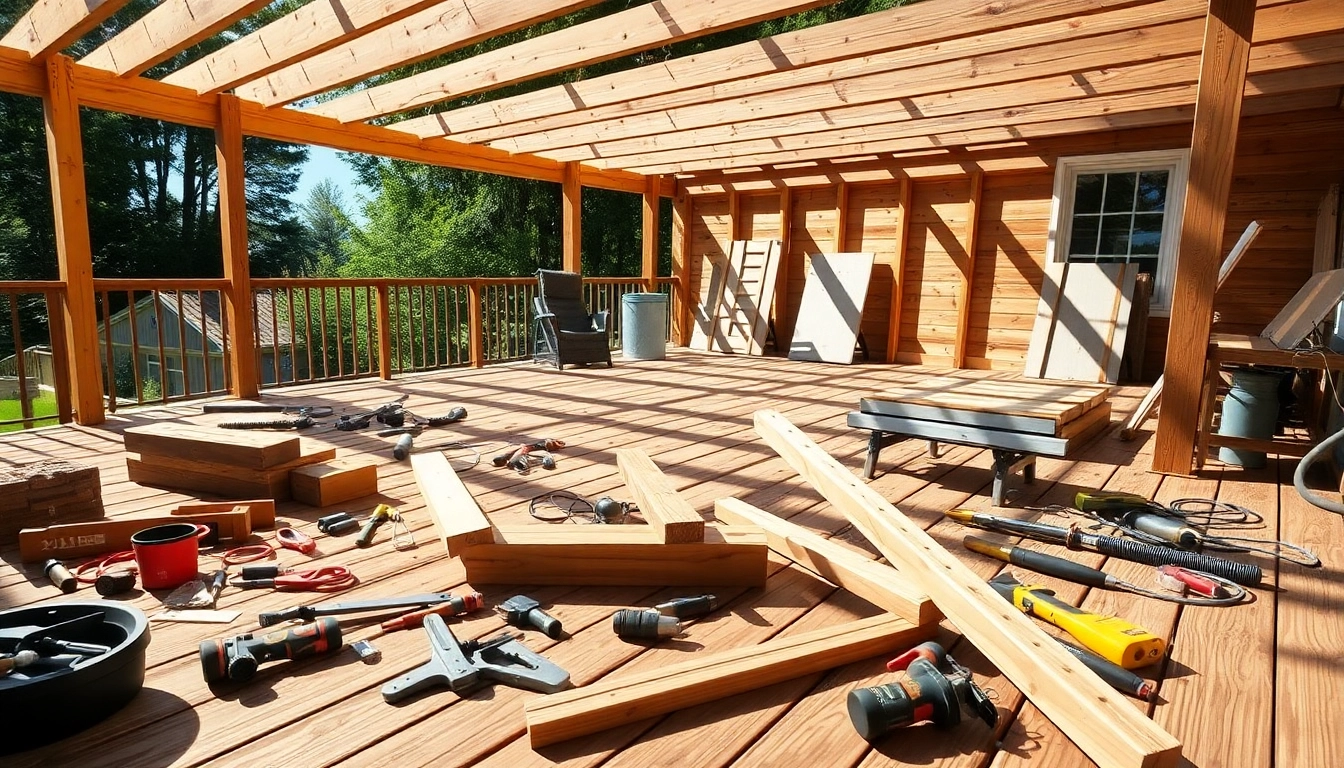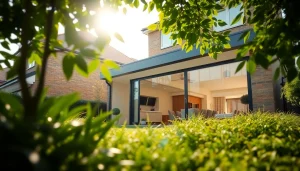Mastering Deck Construction: A Comprehensive Guide to Building Your Dream Deck
Understanding Deck Construction Basics
Building a deck can significantly enhance your home’s aesthetics and functionality while providing an ideal space for relaxation and entertainment. Whether you are a seasoned DIYer or a first-time builder, understanding the fundamentals of deck construction is crucial to your project’s success. This comprehensive guide will explore essential components, materials, and planning strategies for your deck construction project.
Key Components of Decks
A well-constructed deck comprises numerous elements that work together to create a safe and functional outdoor living space. Understanding these key components is vital for both design and structural integrity.
- Footings: These serve as the foundation of your deck, providing stability. Depth and placement depend on local building codes and soil conditions.
- Posts: Vertical supports that transfer the weight of the deck to the ground. Proper installation is crucial for overall stability.
- Beams: Horizontal beams that span the distance between posts, supporting the joists.
- Joists: These are parallel beams that provide the framework for the decking material. They are critical in distributing the weight and ensuring strength.
- Decking: The surface that you walk on. Materials can vary from wood to composite materials.
- Railings: Essential for safety, especially on elevated decks. They may also serve as a design feature.
- Stairs: Access points to the deck, which should also conform to safety regulations.
Choosing Suitable Materials
The material you choose for your deck will greatly influence its durability, maintenance requirements, and overall appearance. Here are some common materials:
- Pressure-treated lumber: This is a cost-effective option, providing decent durability against weather and pests.
- Hardwoods: Options like Ipe or Mahogany are beautiful but come at a higher price point. They are known for their longevity.
- Composite materials: Made from a combination of wood fibers and plastic, they are low maintenance and highly durable but tend to be pricier upfront.
- PVC: An alternative that mimics the appearance of wood, is resistant to fading and warping, making it an excellent low-maintenance option.
Assessing Your Space
Before diving into construction, evaluate your outdoor space. Consider factors such as the size of the area, sunlight, existing structures, and proximity to the house.
- Size: Determine the size of the deck based on how you plan to use the space. Will it be for entertaining, a quiet retreat, or simply to enhance your garden?
- Access: Ensure there’s easy access to and from the house. Consider how foot traffic will flow.
- Local climate: Think about weather patterns in your area, as extreme weather can affect your material choices.
- Aesthetics: Choose styles and materials that complement your home and landscape.
Planning Your Deck Construction Project
A successful deck construction project starts with meticulous planning. Following a structured approach will minimize issues during and after construction.
Creating a Blueprint
Drafting a detailed blueprint for your deck is essential. This blueprint will address dimensions, layout, materials, and features, allowing you to visualize how your deck will integrate with your home and garden.
- Scale drawings: Use graph paper or design software to create a scaled drawing, paying attention to proportions.
- Include features: Incorporate elements like seating, built-in planters, or shade structures.
- Consult professionals if needed: An architect or designer can help refine your plans to ensure functionality and compliance with regulations.
Regulatory Requirements and Permits
Before construction, check local building codes and regulations. Many areas require permits for deck construction, especially for elevated decks.
- Permits: Failing to obtain necessary permits can lead to fines or the need to dismantle your deck.
- Inspections: Understand the inspection process in your area. Inspections may be required at various stages of construction.
- Building codes: Familiarize yourself with local building codes, which may dictate materials, railing height, and load-bearing requirements.
Budgeting for Your Deck
Creating a realistic budget is crucial for your deck construction project. Costs can vary significantly based on size, materials, and additional features.
- Materials: Account for costs of lumber, hardware, and any decorative elements.
- Labor: If hiring professionals, obtain quotes and factor their fees into your budget.
- Contingency fund: Always set aside an additional 10-20% for unexpected expenses that may arise during construction.
Step-by-Step Guide to Building a Deck
Once you’ve completed the planning phase, it’s time to move onto the construction. This step-by-step guide will walk you through the key processes.
Preparing the Site and Foundation
Proper site preparation is vital to ensure your deck is stable and long-lasting. Follow these steps:
- Site clearing: Remove any debris, plants, or structures from the proposed deck area.
- Marking the layout: Use stakes and strings to outline your deck’s perimeter, ensuring that it adheres to your blueprint.
- Excavation: Dig post holes to the required depth. This typically ranges from 36 inches below ground in colder climates.
- Pour concrete footings: Use concrete mix to create solid footings for your posts.
Framing Your Deck
Framing is the skeleton of your deck, providing the necessary support for the decking material.
- Setting the posts: Securely fasten the posts into the previously poured footings and ensure they are vertical.
- Installing beams: Attach the beams to the posts using bolts or brackets, ensuring they are level.
- Joist installation: Install the joists perpendicular to the beams. Space them adequately based on local code and material recommendations.
Installing Decking and Railings
The final steps involve laying down the decking and installing railings for safety and style.
- Installing decking boards: Lay down your chosen decking material across the joists, typically with a gap between boards for drainage.
- Securing railings: Attach railings around the perimeter for safety, ensuring they meet local building codes.
- Finishing touches: Sand any rough edges, add lighting fixtures, and apply weatherproofing or staining as needed.
Advanced Tips for Custom Deck Construction
To take your deck to the next level, consider these advanced tips for customizing your space.
Incorporating Design Features
Customizing your deck can enhance both its functionality and aesthetic appeal. Here are some design features to consider:
- Built-in seating: Consider adding benches or integrated seating areas.
- Lighting: Install ambient lighting for nighttime use, including lanterns, string lights, or recessed lighting.
- Multi-level decks: Incorporating different levels can break up larger spaces, providing a more dynamic look.
Choosing Eco-Friendly Materials
Environmentally friendly materials can create a sustainable outdoor space. Consider these options:
- Bamboo decking: A rapidly renewable resource with excellent durability.
- Recycled composite materials: Create deck boards from recycled plastic and wood fibers, reducing waste.
- Local materials: Using locally sourced wood can lower transportation emissions and support local economies.
Enhancing Functionality and Durability
Simple enhancements can extend your deck’s longevity and usability:
- Weatherproofing: Apply sealants or stains properly to protect wood from the elements.
- Covers and pergolas: Install shade structures to extend your deck’s usability in hot weather.
- Gutter systems: Consider adding gutters to direct rainwater away from your deck.
Maintaining and Upgrading Your Deck
Once your deck is built, regular maintenance is important to keep it in top condition. Learn how to care for and upgrade your deck.
Routine Care and Maintenance Tips
Routine maintenance helps prolong the life of your deck. Follow these tips:
- Regular cleaning: Sweep debris and wash the surface periodically.
- Inspect for damage: Check for signs of wear and tear, including loose boards or rotting materials.
- Reapply finishes: Depending on your material, regularly apply sealants, stains, or paints to protect against the weather.
When to Consider Repairs
Knowing when to repair your deck can prevent further damage:
- Visible wear: If you notice cracks, splintering, or rot, timely repairs can save you from major replacements.
- Shaky railings: If railings feel wobbly, tighten screws and check for damage.
- Mold or mildew: If mold appears, treat it promptly to ensure safety and aesthetics.
Upgrading and Expanding Your Space
As your needs evolve, so might your deck. Consider these options for upgrades:
- Adding levels: Expanding the deck vertically can provide more space for entertaining.
- Incorporating additional seating: Plan areas for furniture or additional built-in seating.
- Extending roofing: Keep your deck usable during rain by adding a roof or cover.
In summary, mastering deck construction involves careful planning, understanding of materials, and diligent maintenance. By paying attention to each stage, from design to upkeep, you can create a beautiful deck that enhances your home and stands the test of time.



